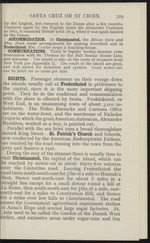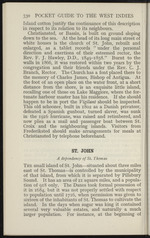| 1 |
 |
“...SANTA CRUZ OR ST CROIX 329
by the English, but restored to the Danes after a few months.
Captured again by the English under Sir Alexander Cochrane
in 1807, it remained British until 1814, when it was again handed
to the Danes.
ACCOMMODATION. In Christiansted, the Misses Quin and
Mrs. Hark make arrangements for passing travellers and in
Frederiksted Mrs. Coulter keeps a boarding-house.
COMMUNICATIONS. There is regular weekly steamer com-
munication with St. Thomas by the Bull Insular House Line,
and schooner. The island is also on the route of steamers from
New York (see Appendix I). The roads of the island are good,
and well suited for motorists and cyclists. Good motor-cars
can be hired for 20 cents per mile.
SIGHTS. Passenger steamers on their voyage down
I the islands usually call at Frederiksted in preference “to
I the capital, since it is the more important shipping
point. They he in the roadstead and communication
with the shore is effected by boats. Frederiksted, or
West End, is...”
|
|
| 2 |
 |
“...raised and retimbered, and
now plies as a mail and passenger boat between St.
Croix and the neighbouring islands. Visitors from
Frederiksted should make arrangements for meals at
Christiansted by telephone beforehand.
ST. JOHN
A dependency of St. Thomas
The small island of St. John—situated about three miles
east of St. Thomas—is controlled by the municipality
of that island, from which it is separated by Pillsbury
Sound. It has an area of 21 square miles, and a popula-
tion of 918 only. The Danes took formal possession of
it in 1684, but it was not properly settled with respect
to population until 1716, when permission was given to
sixteen of the inhabitants of St. Thomas to cultivate the
island. In the days when sugar was king it contained
several very valuable estates, and naturally a much
larger population. For instance, at the beginning of...”
|
|
